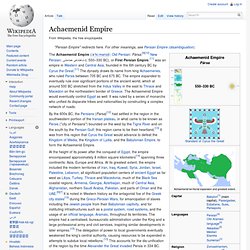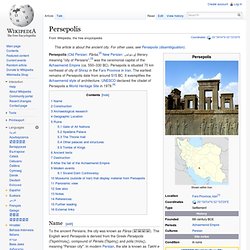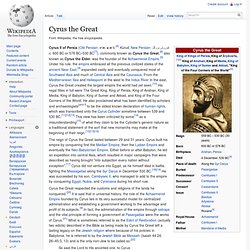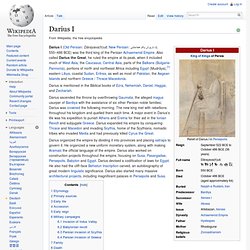

Achaemenid Egypt 525-332 BC. Achaemenid Empire. The Achaemenid Empire (/əˈkiːmənɪd/; Old Persian: Pārsa;[9][10] New Persian: شاهنشاهی هخامنشی c. 550–330 BC), or First Persian Empire,[11] was an empire in Western and Central Asia, founded in the 6th century BC by Cyrus the Great.[11] The dynasty draws its name from king Achaemenes, who ruled Persis between 705 BC and 675 BC.

The empire expanded to eventually rule over significant portions of the ancient world, which at around 500 BC stretched from the Indus Valley in the east to Thrace and Macedon on the northeastern border of Greece. The Achaemenid Empire would eventually control Egypt as well. It was ruled by a series of monarchs who unified its disparate tribes and nationalities by constructing a complex network of roads.
The historical mark of the Achaemenid Empire went far beyond its territorial and military influences and included cultural, social, technological and religious influences as well. History[edit] Achaemenid Timeline[edit] Astronomical year numbering. Persepolis. Persepolis (Old Persian: Pārśa,[2] New Persian: پرسپولیس) literary meaning "city of Persians",[3] was the ceremonial capital of the Achaemenid Empire (ca. 550–330 BC).

Persepolis is situated 70 km northeast of city of Shiraz in the Fars Province in Iran. The earliest remains of Persepolis date from around 515 BC. It exemplifies the Achaemenid style of architecture. UNESCO declared the citadel of Persepolis a World Heritage Site in 1979.[4] Name[edit] To the ancient Persians, the city was known as Pārsa (𐎱𐎠𐎼𐎿). Construction[edit] Archaeological evidence shows that the earliest remains of Persepolis date from around 515 BC. Darius ordered the construction of the Apadana Palace and the Council Hall (the Tripylon or three-gated hall), the main imperial Treasury and its surroundings. Archaeological research[edit] Odoric of Pordenone passed through Persepolis c.1320 on his way to China. Persepolitan architecture is noted for its use of wooden columns.
Geographic Location[edit] Ruins[edit] Cyrus the Great. Cyrus II of Persia (Old Persian: [6] Kūruš; New Persian: کوروش بزرگ c. 600 BC or 576 BC–530 BC[7]), commonly known as Cyrus the Great,[8] also known as Cyrus the Elder, was the founder of the Achaemenid Empire.[9] Under his rule, the empire embraced all the previous civilized states of the ancient Near East,[9] expanded vastly and eventually conquered most of Southwest Asia and much of Central Asia and the Caucasus.

From the Mediterranean Sea and Hellespont in the west to the Indus River in the east, Cyrus the Great created the largest empire the world had yet seen.[10] His regal titles in full were The Great King, King of Persia, King of Anshan, King of Media, King of Babylon, King of Sumer and Akkad, and King of the Four Corners of the World. He also proclaimed what has been identified by scholars and archaeologists[who?] The reign of Cyrus the Great lasted between 29 and 31 years. So said the Lord to His anointed one, to Cyrus Background[edit] Etymology[edit] Dynastic history[edit] Darius I. Darius is mentioned in the Biblical books of Ezra, Nehemiah, Daniel, Haggai, and Zechariah.

Darius organized the empire by dividing it into provinces and placing satraps to govern it. He organized a new uniform monetary system, along with making Aramaic the official language of the empire. Darius also worked on construction projects throughout the empire, focusing on Susa, Pasargadae, Persepolis, Babylon and Egypt. Darius devised a codification of laws for Egypt. He also had the cliff-face Behistun Inscription carved, an autobiography of great modern linguistic significance. Etymology[edit] Dārīus and Dārēus are the Latin form of the Greek Dareios (Δαρεῖος), itself from Old Persian Dārayauš (𐎭𐎠𐎼𐎹𐎢𐏁), which is a shortened form of Dārayavauš (𐎭𐎠𐎼𐎹𐎺𐎢𐏁).
The Modern Persian form is Dāryūsh (داریوش). Primary sources[edit] Darius left a tri-lingual monumental relief on Mount Behistun which was written in Elamite, Old Persian and Babylonian between his coronation and his death. Persians.